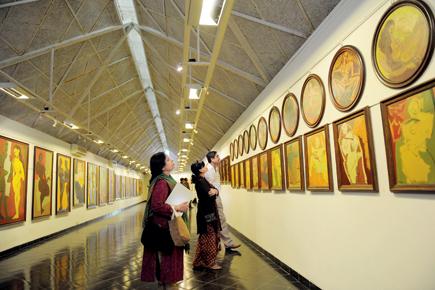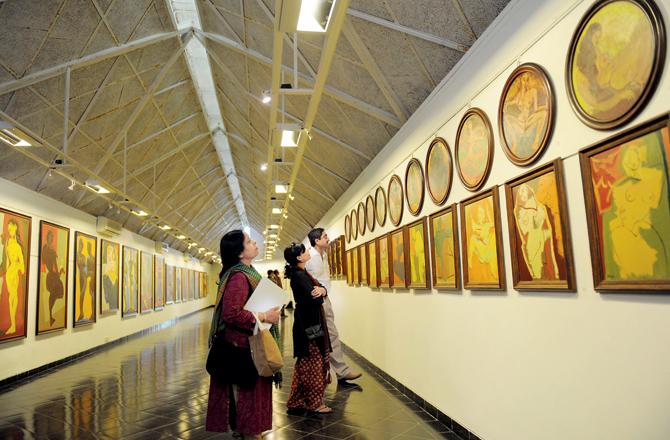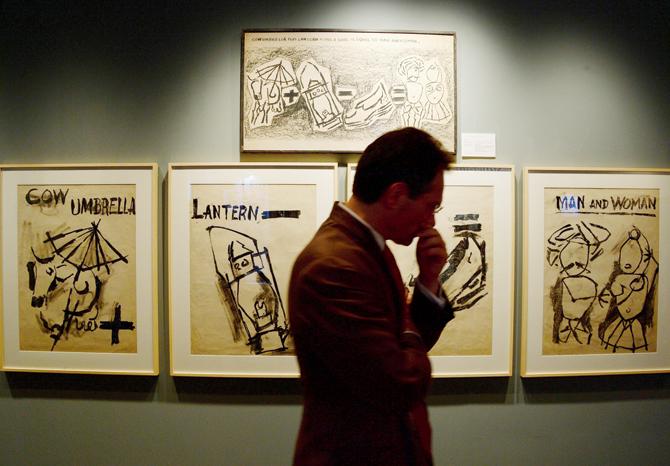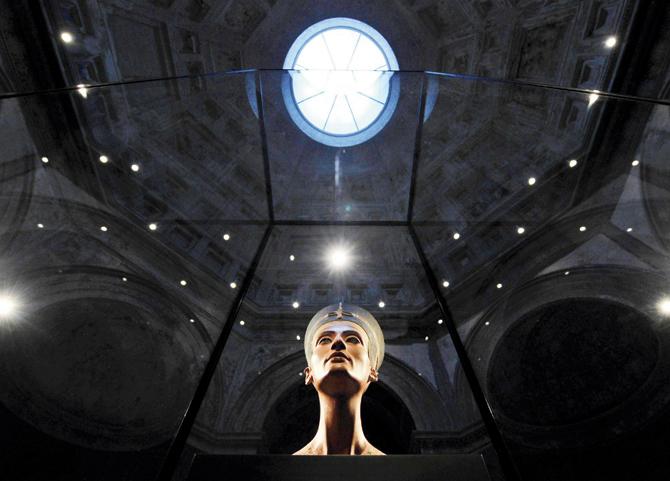Newly appointed CEO of Indian auction house Saffronart, Hugo Weihe, has grand plans to take Indian art and antiquities to different corners of the globe

Amdavad Ni Gufa Gallery
When Hugo Weihe resigned as International Director Of Asian Art at Christie’s, The Telegraph UK reported that the auction house had lost its leading light. Dinesh and Minal Vazirani, founders of the Indian auction house Saffronart, however, saw this as an opportunity and grabbed it. Weihe is considered an expert in the field of Asian art, internationally, having built the Indian and Southeast Asian Art department at Christie’s from scratch.
ADVERTISEMENT

Indian visitors view the paintings of artist Jatin Das on display at the Amdavad Ni Gufa Gallery in Ahmedabad on April 13, 2011. Das is one of India’s most prolific figurative painters. Pic/AFP
He was the main force behind organising its first auction sale in Mumbai in December 2013 and it was under his leadership that Christie’s achieved many record-breaking prices, including the $1.54 million sale of Tyeb Mehta’s Mahisasura. Over the telephone from New York, Weihe, who takes over as CEO of the Saffronart group in July, finds it hard to contain his excitement that he will finally be able to work on the ground in India.
Excerpts from an interview with Hugo Weihe.
Q. Why Saffronart? What made you want to take up this offer?
A. Dinesh and Minal (Vazirani) started Saffronart, 15 years ago, and I have known them for a very long time. I thought it was an extraordinary opportunity. It is a new challenge for me to understand the Indian market, which is at an important juncture now. There is so much potential for growth, which is what excited me. I strongly believe that the future of art lies within Asia. It is great that I have got a chance to be involved in building the market from within, using the rich experience I have picked up from around the world. This was like an obvious next step for me.

Hugo Weihe, former international director of Asian Art at Christie’s, walks past Maqbool Fida Husain’s Cow Umbrella plus Lantern minus a Shoe is equal to Man and Woman during a media preview ahead of Christie’s first auction in India, in Mumbai on December 16, 2013. Pic/AFP
Q. What is your vision for Saffronart in the coming years?
A. Saffronart is a well-positioned company. They deal with Indian art and collectables and showcase art using India as a platform to view the world from. They also do a lot of diverse things — like jewellery, real estate and antiquities. Then, there is also the online auction space, which they are pioneers in. Online sales are cost-effective, but live sales are equally important. The whole feeling of an auction is unmatchable. There is the artwork, a crowd, the fighting and the confidence of an open marketplace. We will try to expand on both terms. It is important to have a well-curated collection. So, we will be working towards that. I believe that the antiquities market has a huge growth potential. But we see that some 2,000-year-old antiquities are not valued as much as modern paintings at times. We are trying to do away with that discrepancy and close that gap. We need to raise awareness among the public on how to value and look at art. I plan to make use my knowledge of the field in a new way. We need to restructure and rethink our ways of looking at art and dealing with it. We also need to leverage modern technology in all its form.
Q. How did you get interested in Indian art and what are the styles that inspire you the most?
A. I have always been very interested by Buddhist sculptures. When I went to Switzerland to study art history, I was particularly interested in learning about cultural exchange. I had the privilege of working with art historian BN Goswamy, and was deeply moved by the Pahari paintings he was studying. What interests me is the movement of ideas and how it affects art. The Gandhara School of Art and the Gupta period fascinate me. Of all the iconic Asian images, I feel Indian art is the most emotive. It has a power from within. I have read somewhere that all art was once contemporary. I am interested in looking at what these artworks meant to their times. I also have a keen interest in the modern artists. When I met Tyeb Mehta, we spoke for so long about his time during the Rockefeller Fellowship, about mythology and his inspirations. I want to connect to these artists and understand the evolution of art. With such a rich art tradition behind you, it is fascinating to learn how these artists use that as a step to take off in their respective new directions.
Q. Your take on the state of India’s contemporary art market.
A. India sits on an extraordinary treasure of 5,000 years of culture. It is a very powerful platform because culture becomes the ambassador of a country to the world. Once you have the right economic means, India can generate new opportunities from this, just like China did. The pride and position the Chinese hold among other countries in the world, now is that moment for India.
Quick Questions with Hugo Weihe
>> Favourite artists: Tough choice. Still, I would go with Leonardo da Vinci and Tyeb Mehta
>> Most promising contemporary artists from Asia: Atul Dodiya and Pakistani artist Rashid Rana
>> Favourite museum: The Metropolitan Museum Of Art, New York
>> Favourite artwork: Nefertiti’s Bust (right), on display at Neues Museum, Berlin
>> Favourite art style: Artworks of the Gupta period
>> Favourite piece of art owned: It is a work on paper. A drawing of a skull by Tyeb Mehta.
 Pic/AFP
Pic/AFP
The bust of Queen Nefertiti of Egypt on display in Berlin’s “Neues Museum” (New Museum) February 7, 2011. The Nefertiti Bust is a 3,400-year-old painted limestone bust of Nefertiti, the Great Royal Wife of the Egyptian Pharaoh Akhenaton and is one of the most copied works of ancient Egypt. Due to the bust, Nefertiti has become one of the most famous women from the ancient world as well as an icon of female beauty. It is believed to have been crafted in 1345 BC by the sculptor Thutmose. Egypt’s Supreme Council of Antiquities demands that Germany return the 3,400 year-old bust of fabled Queen Nefertiti, 98 years after it was uncovered on the banks of the Nile.
 Subscribe today by clicking the link and stay updated with the latest news!" Click here!
Subscribe today by clicking the link and stay updated with the latest news!" Click here!






